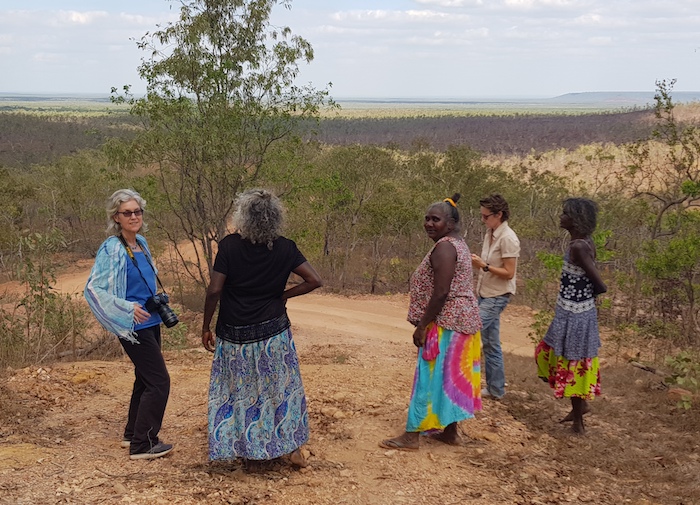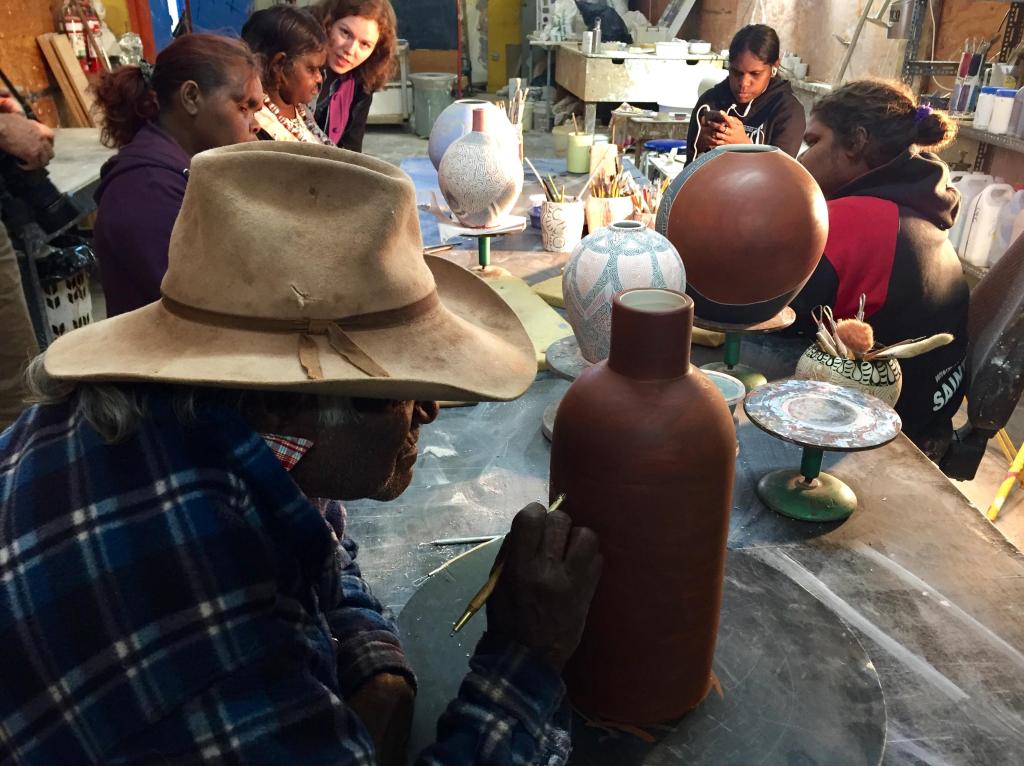Ernabella Arts. Photo: Gina Fairley/ArtsHub (2017).
When I landed at a remote airstrip in the Anangu Pitjantjatjara Yankunytjatjara Lands (APY Lands) in South Australia in July 2017, Heath Arens, the then-manager of Mimilil Maku Arts Art Centre, was patiently waiting for me with a four-wheel drive.
The following day he would be there again to collect a group of patrons visiting from one of the State Galleries. Like the other seven art centres in the APY Lands, Mimilil Maku Arts is not open to passing tourists. These lands are closed, making the role of Art Centre Manager vital in creating connections to markets and the outside world.
While Arens has moved on from Mimilil Maku Arts, and is now manager at Indulkana Art Centre, he told ArtsHub last year: ‘We think it is remote, but the artists from this area have a high level of engagement with the wider world; they are really interested in what is happening in the other arts centres, and what artists are doing in the rest of country, whether Indigenous or non-Indigenous.
‘They are actually really competitive against one another and are really driven and motivated,’ he added. ‘They want to make the best work possible and make the biggest impact.’
Read: Working on Country – what does it mean?
More recently, ArtsHub spoke with the art centre managers of Ernabella Arts – also in the APY Lands, and Australia’s oldest continuously running Indigenous Art Centre – and Bula’bula Arts at Raminginging in remote Arnhem Land (NT), to find out what it takes to be an Aboriginal Art Centre Manager.
How did you get started as an Aboriginal Art Centre Manager?
Hilary Crawford has been manager at Bula’bula Arts since 2015. She told ArtsHub: ‘I was working at an Art Centre in the desert and loved it and thought I could use more of my skills in a job. I was casually looking and saw this job advertised and got a feeling … so I went for it and got it. I started one week after a destructive cyclone and walked into a state of emergency!’
Outside of such emergencies, the pace of life at Bula’bula Arts is a little more laid back, but the weather continues to have a major impact on activities at the centre, at times cutting it off from the rest of the world.
Crawford comes from a glass background, and has a Bachelor of Design (Ceramics and Glass) from the University of South Australia in Adelaide. She did her Honours ANU School of Art and Design’s Glass Workshop in Canberra.
A highlight of her role is ‘being able to live in one of the last great wildernesses on earth with people who I learn so much from every day,’ Crawford said.
She added of the role itself: ‘I am not sure if this is a profession – it is a role that brings together a diversity of professions.’
Mel George stepped into the role of Manager at Ernabella Arts earlier this year. Also trained as a glass artist, she has held positions as Artistic Program Manager at Canberra Glassworks (2009) and Curator for Craft ACT (2013-2016). She founded and subsequently managed Studio Ramp LLC, an artist atelier in Portland, Oregon (USA) for eight years.
George got her start with art centres by working for over a year, consulting for Bula’bula Arts Centre to deepen her understanding of the skills and aesthetics of the Yolngu people. That interest and research was further cemented when George received the inaugural Luminis Foundation Indigenous Fellowship for Cultural Leadership in partnership with NIDA and the Australia Council for the Arts, in 2017.
Taking on the job at Ernabella, George told ArtsHub, was ‘a deliberate move to further my understanding and be part of First Nation people, rather than a “career move”.’

L to R: A visitor to Bula’bula, Julie Djulibing, Lynette Birriran, visiting architect Jo Best Troppo, and Mary Dhapalanu, viewing the Djulibing homelands. A building housing the women’s collection is to be build on and named after the site. Photo: Hilary Crawford.
How has the job changed in recent years?
Crawford told ArtsHub that the industry had changed a great deal due to the global economy.
‘Bula’bula Arts has had strong visibility and recognition since it became an Aboriginal Corporation in 1990,’ she said. ‘Bula’bula has a diversity of incomes, art forms and projects. We need to fulfill our role within the community and make enough income to operate in one of the most remote and expensive places in Australia.’
Arens noted in our interview last year: ‘[The artists] are in control of many aspects of the business. While they do want a successful business – to market the work in the best way possible and have high profile exhibitions and exposure – they also know that the art centres are important places for the community, for learning and passing on knowledge.’
This comment was echoed at the time by Beth Conway, then manager of Iwantja Arts (Indulkana Community): ‘We have really great relationships between the art centres and the ethical galleries that we work with, relationships that have been developed over years in a really supportive manner. The profits coming back to the artists, and the non-profit studios, are a direct result of those strong relationships.’
She continued: ‘Each studio is run by a board of directors and the decision that they have made to work in this manner is really smart decision making and has had great foresight for the longevity of studios and the next generation of artists coming through.’
After several years, Conway has moved on from Iwantja Arts and Arens taken up the role, showing that this is really a very tight and connected community of centre managers.

APY Lands. Photo: ArtsHub (2017).
What makes a good centre manager?
What’s needed for this job? Crawford summed it up in one word: ‘strength’.
She continued: ‘There are so many amazing Art Centre Managers who all have really different strengths. They are all dedicated, willing to go as far as they can to develop things, open to realising new ideas and ways of thinking, strong abilities to connect and listen.’
George added: ‘A good manager needs to have a lot of energy, be extremely hard working, possess a wide variety of practical skills, be a fantastic listener/observer and possess the ability to provide deep empathy.’
She added, ‘You need to be tough with a tender heart.’
George said that undoubtedly, the most valued aspect of the role ‘is working directly with Anangu. The art centre is more than an art studio, it is the heart of the community and facilitates artwork, but also, banking, funerals, Centrelink issues and general day-to-day experiences that are complex when you live remote. The role is to empower and nurture Anangu in art and life.’
What are the great challenges you face in this role?
While the obvious challenge is the isolation, and the dust or rains, there is a resilience and ease that is required to deal with the challenges that come with the role of being the manager of a remote Aboriginal art centre.
Crawford explained: ‘The job brings huge challenges, which is an opportunity for growth. There is challenge for everyone involved with Bula’bula as it is an intensely cross-cultural environment. Everyone in Ramingining, and our 11 surrounding outstations, are still living under Aboriginal law and governance. This is a great strength and an amazing privilege to live within, and very challenging to manage a business within, which has been developed in another system that people do not understand.
‘I try to never assume anything and be open,’ continued Crawford. ‘This role challenges my foundational learning. We are remote and cut off in the wet season; there is so much to do every day that it is a constant process of re-prioritising. I love the challenge and there are many magic moments, and some days I fail.’
George added: ‘Often, a challenge I face is trying to explain to people who have not lived or visited a remote community why it is not possible to “just go to the Mac store” or “just go into the bank”. I have found there is a serious lack of understanding of remote life.
‘One of our younger artists is desperate for a bank account, which is not possible unless you have a form of ID, which she does not have. It is not possible for her to “just go and see…”, fill in the blank,’ said George.
Conway noted that one of the challenges of remote art practice was finding long term staffing and art managers to support and facilitate the making of work.
‘If people come out with the idea of making a two-year commitment, it is a really good amount of time to sink your teeth into some really good projects and make some positive outcomes to work alongside the directors. It is an incredible opportunity that a lot of art school graduates should consider.’
She added: ‘Just trying to find that steady income for artists is challenging. In communities, the art centre is the only place where people can make non-government funded money. It’s their own career pathway; their own career practice and artists are really aware of that and work really hard to maintain that level of professionalism.’
Advice to someone considering this career path
Crawford said that being an art centre manager is an incredible learning opportunity, but added: ‘It doesn’t come easy. Give what you can.’
George added: ‘Choosing this pathway will be a life changing, meaningful and privileged experience.’
She continued: ‘I would recommend this pathway for anyone who wants to contribute towards reconciliation and keeping First Nation culture strong. My advice would be to remember you are on their land and that you will never truly understand what people have been through and are going through.
‘There are so many different elements between the cultural background and the social needs of a community, as well as pushing forward to find marketing opportunities and income for these artists,’ said Conway, before adding that the rewards, however, are worth it.
‘It goes so fast; you get so absorbed into some of the most exciting projects and you can’t leave without seeing them through to completion. And the relationships you form are unlike anything you will ever experience again. It is really hard to leave once you are here,’ she concluded.





